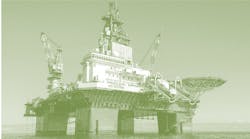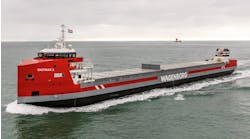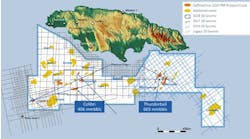View Article as Single page
Float-over vessel requirements
Three essential criteria are required for an HTV to perform a float-over. The first is the width -- the vessel must be narrow enough to fit inside the jacket slot. The larger-sized topsides (15,000 tons) typically have jacket leg clear spacing of around 151 ft (46 m). Assuming nominal clearances, the vessel width is limited to no more than 138 ft (42 m).
Second, the vessel must be equipped with movable casings and designed with an open stern. To ensure the topsides is perfectly positioned onboard the vessel, the casings, which facilitate balance and ballasting, can be moved to best accommodate cargo. The open stern enables the vessel to exit the jacket slot during the last phase of an installation.
Third, HTVs require sufficient strength and stability to support and transport heavy topsides. Various engineering disciplines ensure the cargo is precisely positioned on board the vessel. Prior to loading, the vessel is outfitted with fixed materials and equipment to safeguard the load-out, transport, and installation. The equipment used depends on the installation requirements.
Mooring system
A mooring system needed for most float-over operations should be sized to accommodate expected vessel motions, site environmental conditions, and site geometry. Mooring lines are made up of either steel or polypropylene lines terminating at steel ropes. The lines and their pretensions are calculated and adjusted to provide precise positioning of the vessel and to minimize the motion. The natural period of the vessel needs to be checked to make sure there are no resonance issues.
The mooring system must be small enough to be deployed and disconnected easily, while strong enough to maintain vessel control. Typically, mooring winches with around 121-ton (10-metric ton) pulling capacity and wire size less than 5-6 cm (2-2.4 in.) in diameter are selected. Anything larger will be difficult to handle offshore or will require special winches. For smaller mating lines that terminate at the jacket legs, 50-ton (45-metric ton) capacity winches work well.
The limitations
Each component of a float-over system will have physical limitations in terms of maximum motions or loads. If these limits are exceeded, safety is compromised, but an iterative process can establish these limitations.
Leg mating unit (LMU) and deck support unit (DSU) component geometry determine the motion limits. Maximum LMU excursion radius is restricted mainly by the substructure leg diameter. The maximum excursion radius rarely exceeds 3 ft (1 m).
Vertical and lateral load limits on the LMU and DSU components are determined by the substructure and the topsides structural strength. Usually, the float-over vessel and the specific analyses are not available at the time of the topsides and substructure structural design, so the limits may be set based on experience.
The mooring and mating lines (and fenders, if used) have limits. Barge motion limitations need to be verified so that the vessel does not contact the substructure. In the final analysis, the wave limits are established as a function of approach direction that will allow safe operations.
Workability
Based on the weather limitations for different directions of weather approach for different times of the year and for historical installation site weather data, the next step is to look at the potential workability for the float-over.
Although the workability thus obtained will not be strictly deterministic, the result will guide the potential weather downtime for a given installation period.
Another decision-making tool that can be installed is the vessel motion monitoring system. In this system, the real-time vessel motion in 3D can be viewed along with its trend. When vessel motions are within limits and the trend is favorable, operations can proceed.


